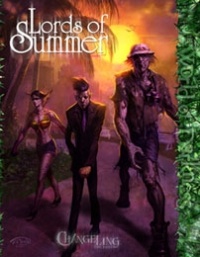Lost Pantheon
From Edge of Darkness Wiki
|
Lords of Summer p. 151-154 | |
| Wyrd | ●●●●●● |
|---|---|
| Clarity | ●●●●●● |
| Preqs | Any Mantle ●●●● |
| This box: view · talk | |
At the dawn of humanity, powerful spirits walked the borders between the earthly and the supernatural. The eldest artworks of Neolithic times depict beings too fanciful to be man, beast, or any other wholly terrestrial thing. Perhaps these entities were the Others, their images captured in ochre and charcoal on the innermost walls of ancient caverns, but some Lost believe that these crude drawings are, instead, images of their own kind -- admired, feared, and even worshiped by primitive mortals. They think back to a more primal and mysterious age, an age during which it seems that the otherworldly walked side-by-side with the mundane, and a balance existed between gods and men. These changelings have resolved to be those very gods in a jaded modern world.
Mien
Ancients of the Lost Pantheon often eschew modern trappings, though this tendency is not universal and some few strike a balance between primordial practices and contemporary existence. Far more common, however, are those that deal almost exclusively with the mortals of their cults, and otherwise keep to the company of the Lost and other beings that dwell beyond the purview of the mundane world. Hedge-spun garments are common to the Ancients, as are clothes made from traditional materials, such as pelts and skins, plant fibers, and the like. Simple jewelry, tattoos and even scarification may adorn a given Ancient's body, and many of them have great difficulty passing among modern mortals.
No single specific change develops in the mien of a member of the Lost Pantheon. Rather, such fae tend simply to become more of what they are, forsaking human appearance for that of their faerie selves: An Elemental of flame transforms into a living conflagration, while a pallid and vaguely necrotic Gravewight comes to look the part of a mummified lich-lord, and a vaguely equine Beast takes on hooves and a windswept mane and seems forever in motion, even when standing still. As Wyrd increases, these changes become increasingly pronounced; particularly potent Ancients actually appear, in many ways, to outside observers like the earthly gods that they believe themselves to be. At the greatest heights of Wyrd, such changelings begin to bend the manifestations of their Mantles, compelling even the blessings of the seasons to conform to their "godly attributes." Thus, a Winter Darkling whose divine aspect is one of hidden places might find a frozen fog envelops her at all times, or a Summer Ogre embodying primal hunger might manifest licking flames within his mouth that occasionally drop embers to consume random small flammable objects, such as papers, dry leaves, and the like
Primordial Incarnation (Privilege)
The powers of the Lost Pantheon reveal the path of its members' supposed "divine transformation" into the entities venerated by humanity in remotest antiquity. Forsaking mortal perspective, these changelings find that the perception-based penalties that they would normally suffer for low Clarity are reversed, becoming bonuses to such rolls (+1 at Clarity 6 to 5, +2 at Clarity 4 to 3, and +3 at Clarity 2 to 1) as their godly eyes open to vistas incomprehensible to human sight. These bonuses are also added to a character's effective Wyrd for the purposes of determining her additional longevity. Every effective dot of Wyrd above 10 adds another 30 years to the changeling's life.
Further, an Ancient may distill Glamour out of the worship of mortals, though doing so necessitates the revelation of one's true form to the unensorcelled. Believers in the Old Ways (or even those who practice new variations on the Old Ways, such as leaving offerings at the rusted scrap metal shrine of the Lady of Drowning Waters along the banks of a polluted river) sustain Ancients toward whom their prayers are directed, though the changeling must be physically present to reap this benefit. Such Glamour is harvested as though it were an emotion appropriate to the changeling's court (even if she is courtless).
Lastly, Ancients of the Lost Pantheon stand firm against the Others in time of conflict and receive a +2 bonus to all rolls to attack, defy, or otherwise engage in either aggression or resistance against the Gentry, their powers, or their minions (such as loyalists, many hobgoblins, some fetches, and the like.)
Joining
As informal as this eldritch order is, it should be no surprise that there is no one single initiation into the Lost Pantheon. In fact, it's rare that one Ancient initiates another. Most feel the call in their dreams, guided by the power of their own Wyrd onto a path that was first trod long ago.
Beasts and Elementals are the seemings most called to the Lost Pantheon, though any changeling inclined toward a primal vision of the world and willing to draw power from that vision (and those mortals that still subscribe to it, to one degree or another) can be drawn to this entitlement. In modern times, the mortals most commonly associated with these beliefs are practitioners of the so-called Old Ways, religious systems with roots stretching back to pre-civilization archetypes that the changelings come to embody: Earth Mothers and Sun Fathers, Bear Women and Wolf Men, and other such atavistic icons. While the practices have changed, their foundations remain, echoing down from the remotest antiquity, from the very first humans to recognize and acknowledge the existence of the supernatural world. Indeed, the so-called Ancients of the Lost Pantheon reflect an age when the distinction between the natural and the supernatural was a line so thin as to be invisible to all save the most cunning and discerning of holy men and wise women.
| |||||||||||||||||||
